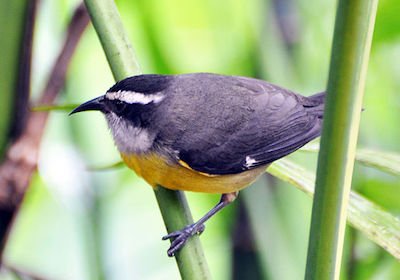Virgin Islands of the United States

Birding the US Virgin Isles
The United States Virgin Islands is a group of islands in the Caribbean that are an insular area of the United States. The islands are geographically part of the Virgin Islands archipelago and are located in the Leeward Islands of the Lesser Antilles.The U.S. Virgin Islands consist of the main islands of Saint Croix, Saint John and Saint Thomas, along with the much smaller but historically distinct Water Island, and many other surrounding minor islands. The total land area of the territory is 133.73 square miles (346.4 km2). As of the 2000 census the population was 108,612.
The U.S. Virgin Islands are located in the Caribbean Sea and the Atlantic Ocean, about 90 miles (140 km) east of Puerto Rico. The territory consists of four main islands: Saint Thomas, Saint John, Saint Croix, and Water Island, as well as several dozen smaller islands. The combined land area of the islands is roughly twice the size of Washington, D.C.The U.S. Virgin Islands are known for their white sand beaches, including Magens Bay and Trunk Bay, and strategic harbors, including Charlotte Amalie and Christiansted. Most of the islands, including Saint Thomas, are volcanic in origin and hilly. The highest point is Crown Mountain, Saint Thomas (1,555 ft/474 m). Saint Croix, the largest of the U.S. Virgin Islands, lies to the south and has a flatter terrain. The National Park Service owns more than half of Saint John, nearly all of Hassel Island, and many acres of coral reef. (See also Virgin Islands National Park, Virgin Islands Coral Reef National Monument, Buck Island Reef National Monument, Christiansted National Historic Site, and Salt River Bay National Historical Park and Ecological Preserve.)The Virgin Islands lie on the boundary of the North American plate and the Caribbean Plate. Natural hazards include earthquakes, tropical cyclones, and hurricanes.
-
Wikipedia
GNU Free Documentation License
http://en.wikipedia.org/wiki/United_States_Virgin_Islands
-
Number of bird species: 260
(As at October 2018) -
Number of bird species:
National Bird: Bananquit Coereba flaveola
- Some have considered the Virgin Islands Screech-Owl Megascops nudipes newtoni to be a full species and endemic although most authorities do not and the race may be the same as that on Puerto rico
-
iGoTerraChecklist
iGoTerra ChecklistFatbirder Associate iGoTerra offers the most comprehensive and up to date birds lists on the web
-
The Birds of the West Indies
| By Guy M Kirwan, Anthony Levesque, Mark W Oberle & Christopher J Sharpe | Lynx Edicions | 2019 | 400 pages, 1600+ colour illustrations, 650+ colour distribution maps | ISBN: 9788416728176 Buy this book from NHBS.com
-
Friends of Virgin Islands National Park
WebsiteThe Friends of Virgin Islands National Park advances the protection and preservation of the natural and cultural resources of Virgin Islands National Park and promotes the responsible enjoyment of this unique national treasure while educating and inspiring adults and children to be stewards of the environment. -
Virgin Islands Audubon Society
Facebook PageThis society is based on St John. The main goal of VIAS is to foster an appreciation for the wildlife in the VI and Caribbean and to protect the habitats. Education is a large component of this effort...
-
NP Virgin Islands National Park
WebsiteSatellite ViewVirgin Islands National Park, renowned throughout the world for its breathtaking beauty, covers approximately 3/5 of St. John, and nearly all of Hassel Island in the Charlotte Amalie harbor on St. Thomas. Within its borders lie protected bays of crystal blue-green waters teeming with coral reef life, white sandy beaches shaded by seagrape trees, coconut palms, and tropical forests providing habitat for over 800 species of plants. Also see the Facebook page. -
NWR Sandy Point & Green Cay
InformationSatellite ViewSandy Point National Wildlife Refuge measures 380 acres in size and is surrounded on three sides by the beautiful turquoise Caribbean Sea. It was established in 1984 for the protection of nesting leatherback turtles. Inland from its sandy beaches, which are critical habitat for sea turtles, littoral woodlands, scrub plant communities and wetlands, of value to assorted species of birds, dominate. At least 100 species of birds have been observed on the refuge of which 22 species have been found nesting here… -
The Salt Ponds
Observatory WebsiteSatellite View…Many wading birds (herons, stilts, sandpipers, and sometimes, flamingos) and waterfowl (ducks, teal, coots) feed on organisms in the ponds. Other birds (kingbirds, martins, and swallows) feed on insects that fly over the ponds, and many nest or roost in the surrounding vegetation. Insect and fish-eating bats also frequent ponds in the evening… -
WS Frank Bay Pond
Observatory WebsiteSatellite ViewFrank Bay Pond was dedicated as a bird sanctuary in March 2000; it is an urban salt pond located one half mile southwest of the Cruz Bay Ferry Dock. It is easily reached by following the paved road keeping the ocean on your right…
-
2008 [06 June] - Ryan Douglas - St Croix
ReportAs this was my honeymoon, I wasn't really birding all that hard. It's entirely possible (likely) I could have seen more birds if this were a dedicated birding trip, but I will warn you that there are much better places to visit in June to look for birds than St. Croix. -
2010 [05 May] - John Thomton
ReportMy wife and I spent an incredible honeymoon in the US Virgin Islands from May 22'nd to the 27'th 2010. I am a crazy birder who was lucky enough to marry an amazing woman who loves to explore new places and go on crazy adventures with me! She would guide me to good spots with her smart phone, and we would hike.
-
The Buccaneer
AccommodationJogging and Nature Trail - A rolling and meandering two-mile trail that includes Par Course work-out stations and signs identifying trees and plants.

